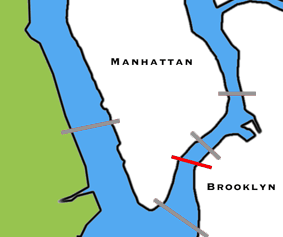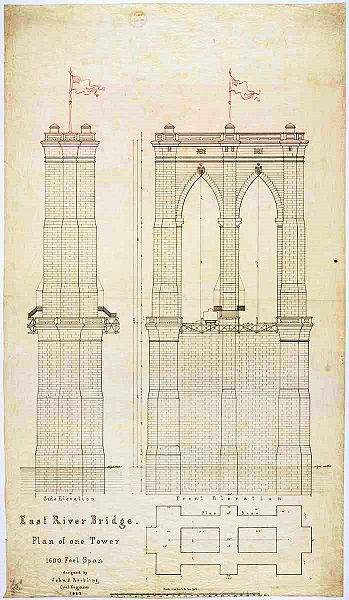
Реферат The building of the Brooklyn Bridge
.docГосударственное образовательное учреждение
Санкт-Петербургский государственный политехнический университет
Инженерно-строительный факультет
Реферат на тему:
The building of the Brooklyn Bridge
по предмету: Английский язык
Выполнил: студент гр. 2015/4
Островский Павел
Санкт-Петербург
2008 год
The sad disaster, which will for long implant on the memory the opening of Brooklyn or East River bridge, is, although so much to be regretted, not so bad as at first feared. For, as the first news it was feared that the vast structure which had been reared with so much pains and labor might not, after all, be stable and sound and then the destruction of life and limb on the crowded bridge would have been awful. The melancholy event has given a double interest in the bridge. The ceremony of opening, which was of a very imposing character, was performed in the presence of President Arthur, the Federal and State officials, and the officers of the New York and Brooklyn Municipal Governments. Both cities were decorated with flags, as were also the vessels in the harbor. A number of warships anchored in the East River, and the guns of the Navy-yard fired salutes, all the church bells were rung in honour of the occasion, and there were general rejoicings. The 7th Regiment of New York escorted President Afthur to the bridge, where the Brooklyn Militia paraded. A grand display of fireworks took place on the bridge.
All these festivities were hardly announced ere the telegraphic tidings of the disaster reached us. The new bridge was the scene of a lamentable panic, with which the nature of its construction had some connection. Whilst a very large crowd was on the bridge on the 30th ultimo, a cry was raised that the structure was giving way. A panic ensued, and the people rushed tumultuously to the ends of the bridge. In the stampede many were trampled under foot. Thirteen persons were killed, and twenty-six are reported to have been injured.
Mr. William C. Kingsley and Mr. Henry C. Murphy, of Brooklyn, were the original projectors of this bridge. Mr. Kingsley conceived the project as early as 1865, selected the site, and hired an engineer to make a plan and estimates. Mr. Murphy was the president of the bridge trustees until last year, when he died, and Mr. Kingsley succeeded him. In 1867 the Bridge Company was chartered with 500,000 dollars nominal capital, 500,000 dollars being aubecribed by prominent people, who organized the company and governed it until 1875, when the bridge was made a public work, and given in charge to the board of trustees. John A. Roebling was the engineer and in 1867 made his plan and estimate, wherein the cost of the bridge proper was given at 7,000,000 dollars, and the approaches 3,800,000 dollars. He then thought the work could be completed in five years. Of this reported plan a board of the leading bridge engineers of the country made a critical examination, and unanimously approved it.
C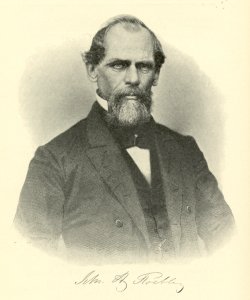 ongress
passed an Act authorizing the bridge in 1869, and the Secretary of
War, in June of that year, gave it his approval as not impeding
navigation, and the work Was then ready to begin. The War Department,
however, required 5ft. additional elevation for the bridge over that
originally planned, making the clearance under it 135ft., and it was
also widened from 80 ft. in the first plan to 85 ft. This added about
8 per cent to the estimated cost. Other changes, in the construction
of the approaches, which are of massive masonry instead of light iron
trusses, as oriningally projected, and the foundations of the towers,
which it was found could not be built on piles, as at first intended,
swelled the cost to the present figure. The approaches are
magnificent viaducts, their supporting archways being constructed for
utilitzation as storehouses, 400,000 dollars being set apart for
putting fronts and floors in them. Another 500,000 dollars has been
devoted to carrying the elevated railways over the bridge and
providing stations.
ongress
passed an Act authorizing the bridge in 1869, and the Secretary of
War, in June of that year, gave it his approval as not impeding
navigation, and the work Was then ready to begin. The War Department,
however, required 5ft. additional elevation for the bridge over that
originally planned, making the clearance under it 135ft., and it was
also widened from 80 ft. in the first plan to 85 ft. This added about
8 per cent to the estimated cost. Other changes, in the construction
of the approaches, which are of massive masonry instead of light iron
trusses, as oriningally projected, and the foundations of the towers,
which it was found could not be built on piles, as at first intended,
swelled the cost to the present figure. The approaches are
magnificent viaducts, their supporting archways being constructed for
utilitzation as storehouses, 400,000 dollars being set apart for
putting fronts and floors in them. Another 500,000 dollars has been
devoted to carrying the elevated railways over the bridge and
providing stations.
The bridge construction was a work of enormous difficulty and constant delays, disensions breaking out frequently, and the two cities being often at loggerheads; but the projectors kept steadily on, and ultimately surmounted every obstacle.
Twenty persons have been killed in the work, over one hundred cases of caisson's disease occurred. The approaches on the New York side begin at Chatham Square and on the Brooklyn side end at Sands and Washington Streets. It is the intention to permit foot passengers to cross free, to charge tolls to vehicles, and to hold the passenger car franchise for the benefit of the bridge at a charge of 5 cents apiece; but since the accident a strong movement has been started in New York, which will doubtless result in the bridge being freed.
The foundations of the tower were laid by the aid of huge caissons, the New York tower being built up from bedrock 80 feet below the surface of the water, and the Brooklyn tower from the clay 45 1/2 feet by two avenues each 31-1/2 ft. wide. These rise 120 1/2 ft. further, above which the full towers are elevated 80 ft. with the saddle that supports the bridge cables resting upon them. In May 1875, the Brooklyn tower was finished, and in July 1876 New York tower.
The bridge floor is 118 ft. above the high water mark at the towers and 135 ft. in the center span. Our figures on the front page show some details of the bridge. The anchorage of piers and the head with expansion pulleys are shown at top of the engraving while under the plan elevation a section of the bridge is given. An enlargement to show the bracing is also given.
A view of the piers when in course of construction is also given from an American contemporary. The framework consists essentially of two systems of girders at right angles to each other. The principal cross beams or girders supporting the floor proper are light trusses 33 inches deep placed 7 ft. 6 in. apart, and to these are attached the four steel rope suspenders from the cables.
Halfway between these principal floor beams are lighter ones, to give additional support to the planking. To unite these cross beams together, and to give the proper amount of stiffness and strength to the floor, are the six parallel trusses extending along the entire length of the bridge. The floor beams are further united together by small logitudinal trusses extending from one to the other, which, together with a complete system of diagonal braces or stays, form a longitudinal truss of 86ft. in breadth. It will be seen, thus, that this combination has immense strength. weight, and stiffness, laterally and vertically, and in every direction.
To relieve the cables in some measure of the enormous burden and at the same time effectually prevent any vertical oscillations in the bridge floor, there is a multitude of suspensory stays of steel wire ropes diverging from the tops of the towers to points about 15 ft. apart along the bottom of four of the vertical trusses. These stays extend out for a distance of 400 ft. from the towers, and are of themselves capable of sustaining unaided that portion of the roadway and its load in position. At the towers the girder-work is firmly anchored down, and again confined against the lifting or pushing force of the wind by a system of under-stays lying in the plane of the floor, so that no conceivable cause can ever disturb its rigid fixity of position and form.
At and near the centre of the span, however, where these stays do not act efficiently against any tendency to distortion, and to still further unite and stiffen the whole system, the two outside cables are drawn inward toward each other at the bottom of their curves. By this means each of them presents its weight in the form of an arch against an oblique pressure from below and the opposite side and resists more or less in the same way any force from the like directions. The two inner cables at the same time are drawn apart at the bottom of their curves, thus approaching each its outside neighbour, and pairing with it, so as to combine their opposing arches against lateral forces from either direction. The weight of the whole suspended structure, central span, cables and all, is 6,740 tons, and the maximum weight with which the bridge can be crowded by freely moving passengers, vehicles, and cars is estimated at 1,380 tons, making the total weight borne by the towers, 8,120 tons.
Источник: «The Illustrated Carpenter and Builder» June 8, 1883 /www.endex.com/
Painters on the cables
1896 Panorama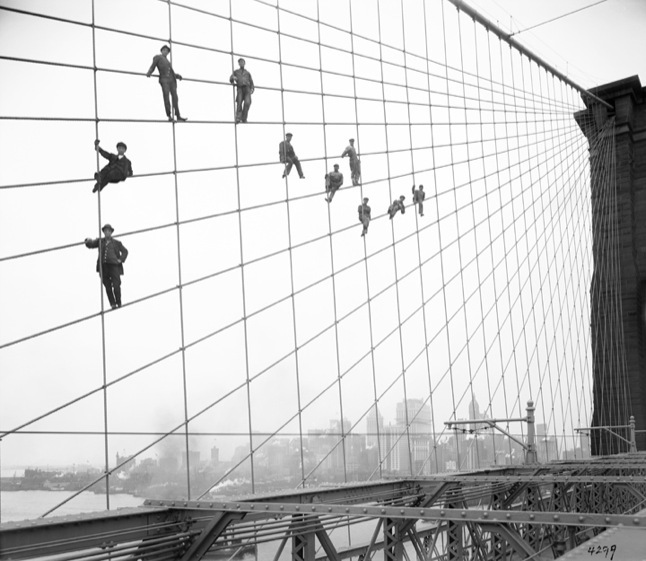
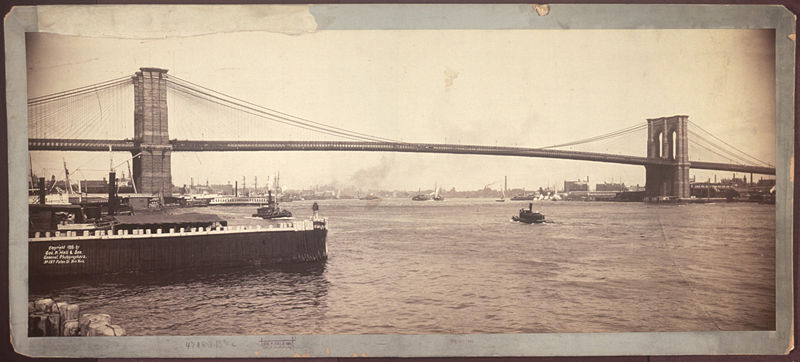
The
anchor of cables
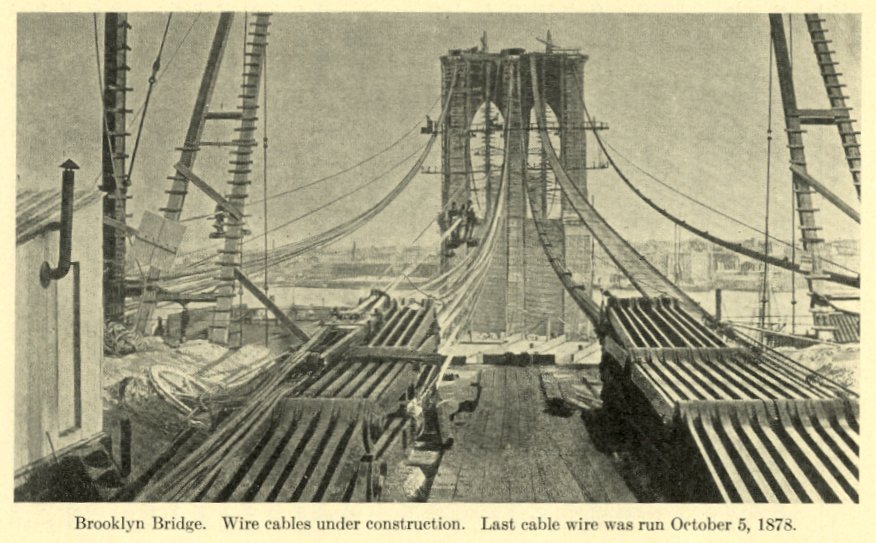

Opening Ceremonies May 24, 1883 The
frame


